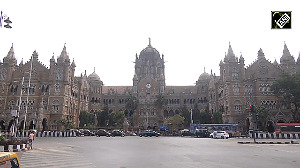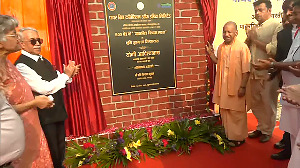Of all the provisions in India's draft safeguards agreement with the International Atomic Energy Agency, the termination clause in Paragraph 29 has occasioned considerable debate. One of India's lead negotiators, Dr R B Grover of the Department of Atomic Energy, claimed in a press conference on Saturday that this paragraph, read together with others in the agreement, gave India all the legal protection it needed in case a fuel supply arrangement for a safeguarded indigenously manufactured reactor were ever to break down.
This claim has been wrongly contested, with some analysts questioning the relevance of a 1973 IAEA document mentioned in that paragraph to the duration and termination of safeguards on an indigenous, non-imported nuclear facility.
Paragraph 29 -- which is unique to the Indian safeguards agreement and is not found in any other IAEA safeguards agreement -- states: 'The termination of safeguards on items subject to this Agreement shall be implemented taking into account the provisions of GOV/1621 (20 August 1973)'. GOV/1621 is not a secret document. It is "restricted" as per the conservative procedures of the IAEA Board but was made available to the public in 1985 by Jozef Goldblat, whose edited book, Safeguarding the Atom: A Critical Appraisal(Taylor & Francis, 1985), reproduced it as Appendix VI.
The document, which is available online here, deals with the 'duration and termination of Infcirc/66 agreements". India's draft safeguards text belongs to that class of agreements for location-specific safeguards in a country that is not a party to the Nuclear Non-proliferation Treaty.
The reason GOV/1621 was adopted was because Infcirc/66 (Rev 2) is silent about the duration of safeguards except to note that 'it is desirable that safeguards agreements should provide for the continuation of safeguards, subject to the provisions of this document, with respect to produced special fissionable material and to any materials substituted therefor' (Paragraph 16) (emphasis added).
As far as termination of safeguards on materials subject to such agreements is concerned, Paragraph 26 provides for eight conditions under which 'nuclear material shall no longer be subject to safeguards'. These are numbered (a) to (f). The last of these, ie, 26(f) says safeguards on nuclear material shall no longer apply if: 'The conditions specified in the safeguards agreement, pursuant to which it was subject to Agency safeguards, no longer apply, by expiration of the agreement or otherwise'.
India has got the best possible agreement
Significantly, Infcirc/66 is silent on the termination of safeguards in a nuclear facility like a reactor. Since it was envisaged that all such facilities would be supplied from the outside, the understanding was that duration and termination would be fixed by the relevant bilateral agreement pursuant to which the facility was being supplied. Thus, for example, Section 27 of Infcirc/154, the 1971 safeguards agreement governing the transfer of the Tarapur reactor from the US to India, notes that the agreement shall remain in force during the term of the (bilateral) agreement for cooperation, wherein 30 years was mentioned. But a question mark prevailed over the termination of safeguards being implemented on 'certain nuclear activities' within a State under the latter's jurisdiction which are offered by that state for safeguards to the IAEA under Paragraph 15(c).
GOV/1621 introduced two changes in the Infcirc/66 regime. Paragraph 1(a) states the context: 'A substantial number of Governors have urged that there should be a greater degree of standardization than in the past with respect to the duration and termination of such agreements as may henceforth be concluded under the Agency's Safeguards System (1965, as Provisionally Extended in 1966 and 1968) [ie, Infcirc/66 (Rev 2)] for the application of safeguards in connection with nuclear material, equipment, facilities or non-nuclear material supplied to States by third parties'.
To achieve this, it recommended that two concepts should be reflected in these agreements. The first was that 'the duration of the agreement should be related to the period of actual use of the items in the recipient state'. Second, that termination provisions allow for the continuation of safeguards over any products derived from the supplied nuclear material (ie, pursuit clause).
Text of India's draft IAEA safeguards agreement
The document then provides what it calls 'a short exposition with respect to the application of these concepts' in an Annex which has four paragraphs. These make it clear that all supplied material and facilities remain under safeguards for the duration of their actual use and even after (under the pursuit clause). But what of facilities that are indigenous and have not been 'supplied'? Under what circumstances could they be removed from safeguards? This is where Paragraph 3 of the Annex is relevant. It notes that 'with respect to equipment, facilities and non-nuclear material, conditions for removal could be based on paragraph 26 [of Infcirc/66 (Rev. 2)]'.
In other words, for non-supplied facilities, GOV/1621 says termination of safeguards could be based on paragraph 26 of Infcirc/66, thereby extending the eight conditions under which safeguards on nuclear material can be terminated to nuclear facilities.
Let us look at 26(f) again, and read it, this time, as a condition under which a non-supplied facility can be removed from safeguards. Thus, safeguards on an indigenous facility could be terminated if: 'The conditions specified in the safeguards agreement, pursuant to which it was subject to Agency safeguards, no longer apply, by expiration of the agreement or otherwise'.
Once 26(f) of Infcirc/66 (Rev. 2) is read with GOV/1621 and Paragraph 29 of the India-specific safeguards agreement, it should become obvious that what is crucial in determining duration and termination are 'the conditions specified in the safeguards agreement pursuant to which' any indigenous facility India voluntarily offered 'was subject to safeguards'. Those conditions are found:
The nuclear deal's essence is politics
In the event of a supplier abrogating a fuel supply arrangement for indigenous facility X, say -- the continuation of which is essential to the accomplishment of the objective of safeguards on that facility -- India could determine that the conditions specified in the safeguards agreement, pursuant to which it was subject to Agency safeguards, no longer apply (ie, the termination condition allowed by GOV/1621) and end safeguards on that facility once all foreign supplied material has been removed.
This is presumably what Atomic Energy Commission chairman Anil Kakodkar meant when he said on July 12 thatperpetuity of safeguards was linked to perpetuity of fuel supplies. But lest the non-proliferation critics in the US cite this as a deviation from what India had committed itself to, it is worth looking at the March 2, 2006, separation plan again. Paragraph 15 (c) says:
'An India-specific safeguards agreement will be negotiated between India and the IAEA providing for safeguards to guard against withdrawal of safeguarded nuclear material from civilian use at any time as well as providing for corrective measures that India may take to ensure uninterrupted operation of its civilian nuclear reactors in the event of disruption of foreign fuel supplies. Taking this into account, India will place its civilian nuclear facilities under India-specific safeguards in perpetuity and negotiate an appropriate safeguards agreement to this end with the IAEA'.
This is precisely what the draft Indian safeguards agreement provides for.
The fear has been expressed in some quarters that since India's separation plan offers several facilities for safeguards -- not just reactors, but also heavy water plants, research and storage facilities -- these too will be under perpetual safeguards since the link between the import of fuel and the duration of safeguards is not relevant for them. Research facilities, for example, do not even import fuel. In reality, these facilities are all safeguards-irrelevant because they do not involve the use of any nuclear material that has to be safeguarded.
Thus, they will never be subject to safeguards in the first place. In the case of heavy water plants, in fact, the draft Indian safeguards agreement amplifies this by excluding production plants from its definition of heavy water facilities in paragraph 117(f). There, such facilities are defined as 'a plant for the upgrading of heavy water or a separate storage installation for heavy water'. All of this is fully consistent with the March 2006 separation plan, which explicitly stated that India's heavy water plants designated for civilian use were 'safeguards-irrelevant'.
But again, it is important to reiterate a fundamental point with the safeguards agreement and indeed the entire civil nuclear initiative India is going in for.
Agreements may provide rights but this does not mean asserting them or implementing them will be easy. India may consider itself to be on firm legal ground in invoking Paragraph 29, for example, in order to deal with the consequences of a fuel supply disruption, but the political opposition it will encounter internationally could be formidable. Some of this political opposition could even be couched in legal terms. Even if the right to withdraw facilities from safeguards were stated explicitly and upfront, as some have suggested India should have insisted on, the level of international opposition as and when India were to invoke that right would hardly be less strident.
The prudential strategy, therefore, is not to be complacent about one's right to take corrective measures but to utilise all the pre-emptive rights the agreement provides for in terms of fuel supply arrangements and stockpiles so that at any time, the country has, on its own territory, a buffer of five to seven years of nuclear fuel for each of the reactors it is placing under safeguards. A prudential strategy would also involve importing the least possible number of reactors, especially from the United States which is seeking to impose extraneous conditions aimed at impinging on the country's sovereignty.
Siddharth Varadarajan is Associate Editor of The Hindu in New Delhi. He also blogs at https://svaradarajan.blogspot.com







 © 2025
© 2025